How to avoid being scammed via emails like "Microsoft Lottery" scam email
Phishing/ScamAlso Known As: Microsoft Lottery phishing email
Get free scan and check if your device is infected.
Remove it nowTo use full-featured product, you have to purchase a license for Combo Cleaner. Seven days free trial available. Combo Cleaner is owned and operated by RCS LT, the parent company of PCRisk.com.
What is "Microsoft Lottery"?
After analyzing this email, our team has concluded that its intent is to deceive recipients into divulging personal information. Such emails are commonly known as phishing emails. The email in question alleges that the recipient has won a lottery, but all of the claims made in the email are false. Therefore, it is recommended to disregard it.
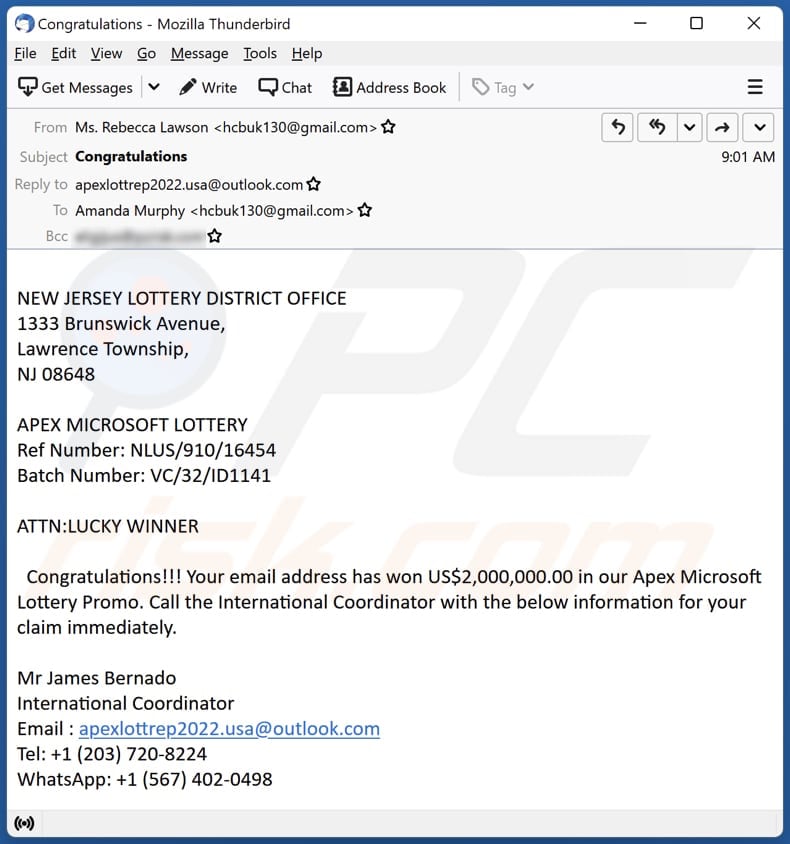
More about the "Microsoft Lottery" scam email
This is a phishing email that claims to be from the New Jersey Lottery District Office and the Apex Microsoft Lottery, and alleges that the recipient has won a lottery worth US$2,000,000. The email provides a reference number and batch number to make it appear more legitimate.
The email instructs the recipient to contact the International Coordinator, Mr. James Bernado, immediately to claim the prize. The email also includes an email address, telephone number, and WhatsApp number to contact Mr. Bernado. However, this email is a scam and should not be trusted.
The purpose of this phishing email is to deceive the recipient into providing personal information or paying a fee to claim the prize (or both). Thus, recipients should ignore this phishing email and not respond to it in any way. They should not provide any personal information or pay any fees.
| Name | Microsoft Lottery Email Scam |
| Threat Type | Phishing, Scam, Social Engineering, Fraud |
| Fake Claim | The recipient has won a lottery |
| Scammer's Phone Number | +1 (203) 720-8224, +1 (567) 402-0498 |
| Disguise | Letter from Apex Microsoft Lottery |
| Symptoms | Unauthorized online purchases, changed online account passwords, identity theft, illegal access of the computer. |
| Distribution methods | Deceptive emails, rogue online pop-up ads, search engine poisoning techniques, misspelled domains. |
| Damage | Loss of sensitive private information, monetary loss, identity theft. |
| Malware Removal (Windows) |
To eliminate possible malware infections, scan your computer with legitimate antivirus software. Our security researchers recommend using Combo Cleaner. Download Combo CleanerTo use full-featured product, you have to purchase a license for Combo Cleaner. 7 days free trial available. Combo Cleaner is owned and operated by RCS LT, the parent company of PCRisk.com. |
Similar scam emails in general
These emails often appear to come from a reputable source, such as a bank, government agency, or well-known company. The emails typically include a sense of urgency or fear, urging the recipient to take immediate action to avoid negative consequences. Typically, they request credit card details, login credentials, or other sensitive information.
Examples of phishing emails are "Voice Message In Your Office365 Extension", "New Project Proposal", and "Quotation Of Goods". It is important to know that emails sent by cybercriminals can be utilized to distribute malicious software.
How do spam campaigns infect computers?
Threat actors aim to infect computers by tricking recipients into downloading and activating malware through malicious email attachments or links. It's crucial to recognize that not all malicious files will infect a computer upon opening.
Cybercriminals distribute malware using various file types, including malicious MS Office or PDF documents, executables, JavaScript files, archives, and ISO files.
How to avoid installation of malware?
Avoid opening email links or attachments from unknown sources, especially if they seem irrelevant/unsolicited. Download software (and files) only from trustworthy sources like verified stores or official websites. Do not click ads on dubious websites. Keep the operating system and software up to date. Use reliable antivirus software and perform regular system scans.
If you've already opened malicious attachments, we recommend running a scan with Combo Cleaner Antivirus for Windows to automatically eliminate infiltrated malware.
Text presented in the "Microsoft Lottery" email letter:
Subject: Congratulations
NEW JERSEY LOTTERY DISTRICT OFFICE
1333 Brunswick Avenue,
Lawrence Township,
NJ 08648APEX MICROSOFT LOTTERY
Ref Number: NLUS/910/16454
Batch Number: VC/32/ID1141ATTN:LUCKY WINNER
Congratulations!!! Your email address has won US$2,000,000.00 in our Apex Microsoft Lottery Promo. Call the International Coordinator with the below information for your claim immediately.
Mr James Bernado
International Coordinator
Email : apexlottrep2022.usa@outlook.com
Tel: +1 (203) 720-8224
WhatsApp: +1 (567) 402-0498
Another example of an email from "Microsoft Lottery" spam campaign:
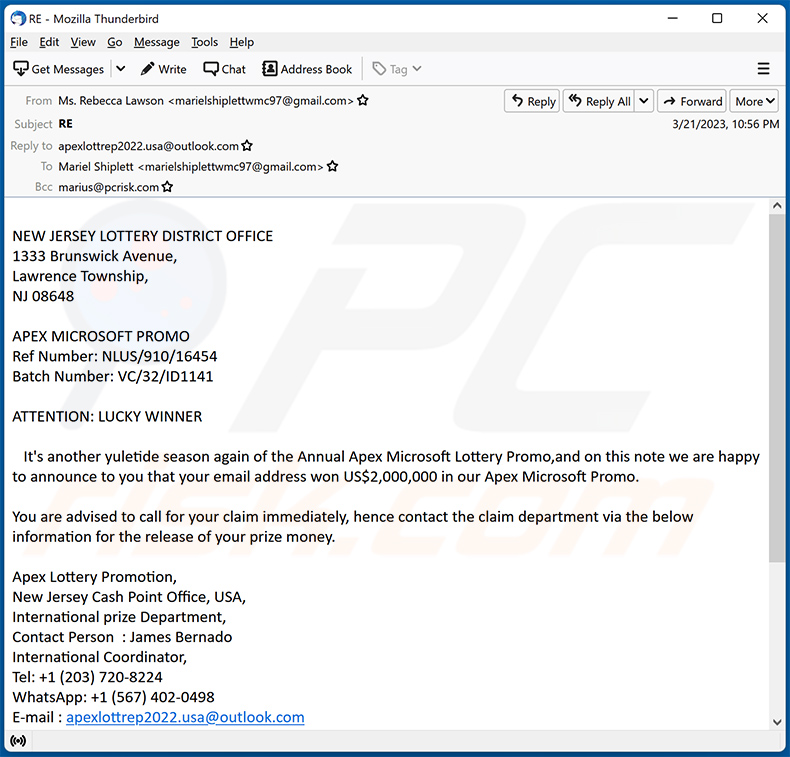
Text presented within:
Subject: RE
NEW JERSEY LOTTERY DISTRICT OFFICE
1333 Brunswick Avenue,
Lawrence Township,
NJ 08648APEX MICROSOFT PROMO
Ref Number: NLUS/910/16454
Batch Number: VC/32/ID1141ATTENTION: LUCKY WINNER
It's another yuletide season again of the Annual Apex Microsoft Lottery Promo,and on this note we are happy to announce to you that your email address won US$2,000,000 in our Apex Microsoft Promo.
You are advised to call for your claim immediately, hence contact the claim department via the below information for the release of your prize money.
Apex Lottery Promotion,
New Jersey Cash Point Office, USA,
International prize Department,
Contact Person : James Bernado
International Coordinator,
Tel: +1 (203) 720-8224
WhatsApp: +1 (567) 402-0498
E-mail : apexlottrep2022.usa@outlook.comWe advise you to contact the International Coordinator via his email or simply contact him through WhatsApp for confirmation, and once you establish communication with Mr James Bernado ( International Coordinator) kindly update me on here so i can keep for the office record keeping
CONGRATULATIONS ONCE MORE!!!
Yours faithfully,
Ms. Rebecca Lawson
Online Coordinator
Yet another email from "Microsoft Lottery" spam campaign:
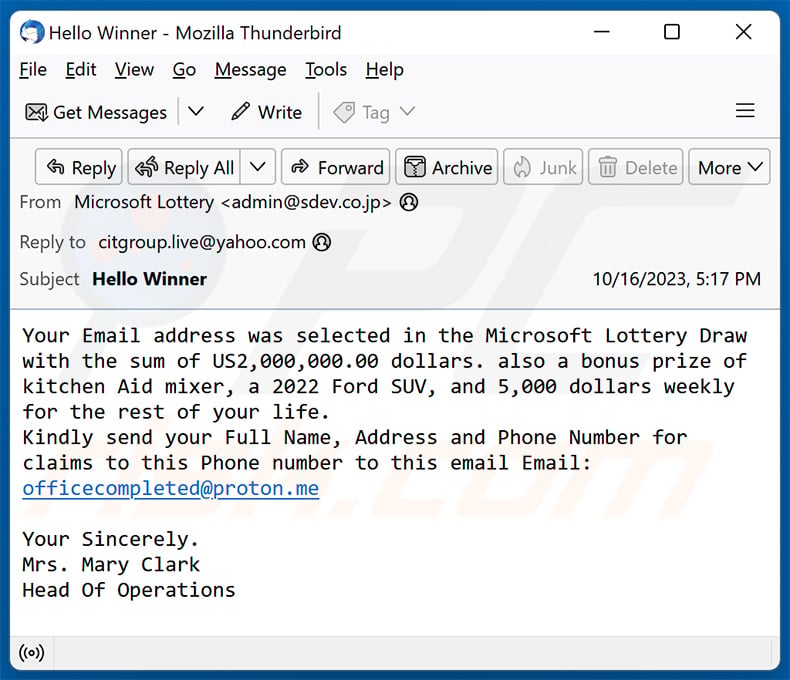
Text presented within:
Subject: Hello Winner
Your Email address was selected in the Microsoft Lottery Draw with the sum of US2,000,000.00 dollars. also a bonus prize of kitchen Aid mixer, a 2022 Ford SUV, and 5,000 dollars weekly for the rest of your life.
Kindly send your Full Name, Address and Phone Number for claims to this Phone number to this email Email: officecompleted@proton.meYour Sincerely.
Mrs. Mary Clark
Head Of Operations
Another example of Microsoft lottery-themed spam email:
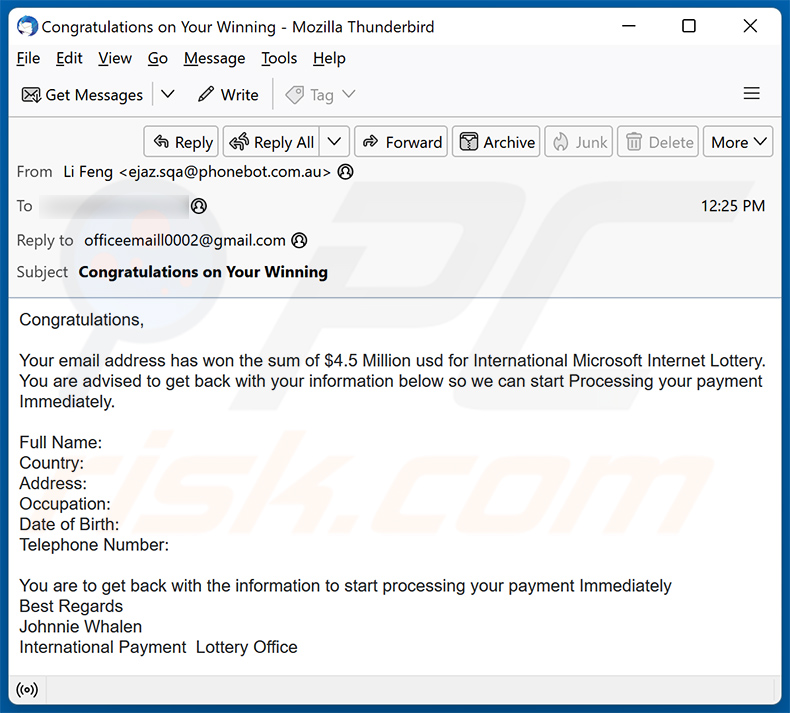
Text presented within:
Subject: Congratulations on Your Winning
Congratulations,Your email address has won the sum of $4.5 Million usd for International Microsoft Internet Lottery.
You are advised to get back with your information below so we can start Processing your payment Immediately.Full Name:
Country:
Address:
Occupation:
Date of Birth:
Telephone Number:You are to get back with the information to start processing your payment Immediately
Best Regards
Johnnie Whalen
International Payment Lottery Office
Instant automatic malware removal:
Manual threat removal might be a lengthy and complicated process that requires advanced IT skills. Combo Cleaner is a professional automatic malware removal tool that is recommended to get rid of malware. Download it by clicking the button below:
DOWNLOAD Combo CleanerBy downloading any software listed on this website you agree to our Privacy Policy and Terms of Use. To use full-featured product, you have to purchase a license for Combo Cleaner. 7 days free trial available. Combo Cleaner is owned and operated by RCS LT, the parent company of PCRisk.com.
Quick menu:
- What is Microsoft Lottery phishing email?
- Types of malicious emails.
- How to spot a malicious email?
- What to do if you fell for an email scam?
Types of malicious emails:
![]() Phishing Emails
Phishing Emails
Most commonly, cybercriminals use deceptive emails to trick Internet users into giving away their sensitive private information, for example, login information for various online services, email accounts, or online banking information.
Such attacks are called phishing. In a phishing attack, cybercriminals usually send an email message with some popular service logo (for example, Microsoft, DHL, Amazon, Netflix), create urgency (wrong shipping address, expired password, etc.), and place a link which they hope their potential victims will click on.
After clicking the link presented in such email message, victims are redirected to a fake website that looks identical or extremely similar to the original one. Victims are then asked to enter their password, credit card details, or some other information that gets stolen by cybercriminals.
![]() Emails with Malicious Attachments
Emails with Malicious Attachments
Another popular attack vector is email spam with malicious attachments that infect users' computers with malware. Malicious attachments usually carry trojans that are capable of stealing passwords, banking information, and other sensitive information.
In such attacks, cybercriminals' main goal is to trick their potential victims into opening an infected email attachment. To achieve this goal, email messages usually talk about recently received invoices, faxes, or voice messages.
If a potential victim falls for the lure and opens the attachment, their computers get infected, and cybercriminals can collect a lot of sensitive information.
While it's a more complicated method to steal personal information (spam filters and antivirus programs usually detect such attempts), if successful, cybercriminals can get a much wider array of data and can collect information for a long period of time.
![]() Sextortion Emails
Sextortion Emails
This is a type of phishing. In this case, users receive an email claiming that a cybercriminal could access the webcam of the potential victim and has a video recording of one's masturbation.
To get rid of the video, victims are asked to pay a ransom (usually using Bitcoin or another cryptocurrency). Nevertheless, all of these claims are false - users who receive such emails should ignore and delete them.
How to spot a malicious email?
While cyber criminals try to make their lure emails look trustworthy, here are some things that you should look for when trying to spot a phishing email:
- Check the sender's ("from") email address: Hover your mouse over the "from" address and check if it's legitimate. For example, if you received an email from Microsoft, be sure to check if the email address is @microsoft.com and not something suspicious like @m1crosoft.com, @microsfot.com, @account-security-noreply.com, etc.
- Check for generic greetings: If the greeting in the email is "Dear user", "Dear @youremail.com", "Dear valued customer", this should raise suspiciousness. Most commonly, companies call you by your name. Lack of this information could signal a phishing attempt.
- Check the links in the email: Hover your mouse over the link presented in the email, if the link that appears seems suspicious, don't click it. For example, if you received an email from Microsoft and the link in the email shows that it will go to firebasestorage.googleapis.com/v0... you shouldn't trust it. It's best not to click any links in the emails but to visit the company website that sent you the email in the first place.
- Don't blindly trust email attachments: Most commonly, legitimate companies will ask you to log in to their website and to view any documents there; if you received an email with an attachment, it's a good idea to scan it with an antivirus application. Infected email attachments are a common attack vector used by cybercriminals.
To minimise the risk of opening phishing and malicious emails we recommend using Combo Cleaner Antivirus for Windows.
Example of a spam email:
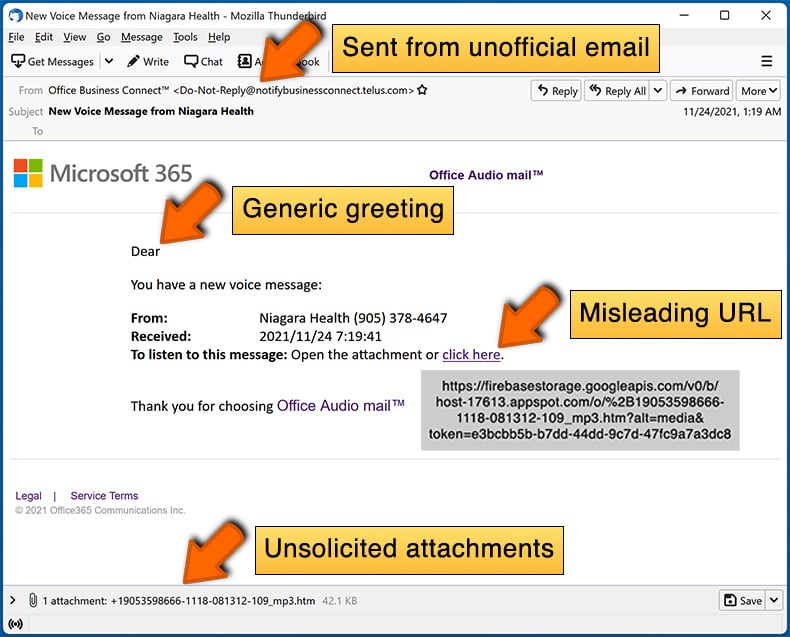
What to do if you fell for an email scam?
- If you clicked on a link in a phishing email and entered your password - be sure to change your password as soon as possible. Usually, cybercriminals collect stolen credentials and then sell them to other groups that use them for malicious purposes. If you change your password in a timely manner, there's a chance that criminals won't have enough time to do any damage.
- If you entered your credit card information - contact your bank as soon as possible and explain the situation. There's a good chance that you will need to cancel your compromised credit card and get a new one.
- If you see any signs of identity theft - you should immediately contact the Federal Trade Commission. This institution will collect information about your situation and create a personal recovery plan.
- If you opened a malicious attachment - your computer is probably infected, you should scan it with a reputable antivirus application. For this purpose, we recommend using Combo Cleaner Antivirus for Windows.
- Help other Internet users - report phishing emails to Anti-Phishing Working Group, FBI’s Internet Crime Complaint Center, National Fraud Information Center and U.S. Department of Justice.
Frequently Asked Questions (FAQ)
Why did I receive this email?
Phishing emails are typically not personal. They are not tailored specifically to an individual recipient. Instead, they are usually sent out in bulk to many email addresses, often using automated software.
I have provided my personal information when tricked by this email, what should I do?
In case you have given away any account login information, it is important that you alter all passwords without delay. If you have shared any other personal details like credit card or ID card information, it is advisable to reach out to the relevant authorities as soon as possible.
I have downloaded and opened a file attached to an email, is my computer infected?
If it was a document such as a .pdf or .doc file, there is a possibility that the system may not have been infected simply by opening the file, as some types of malware require further action to infiltrate the system. However, if the opened file was executable, your computer is probably already infected.
I have read the email but did not open the attachment, is my computer infected?
Opening an email is generally harmless and cannot infect a system with malware. However, clicking on links or opening attachments within an email can potentially lead to a system infection.
Will Combo Cleaner remove malware infections that were present in email attachment?
Combo Cleaner can detect and remove nearly all known malware infections. However, it is important to note that some advanced forms of malware may be deeply embedded in the system, making them difficult to detect and remove. Thus, it is recommended to perform a full system scan to ensure that any hidden malware is identified and eliminated.
Share:

Tomas Meskauskas
Expert security researcher, professional malware analyst
I am passionate about computer security and technology. I have an experience of over 10 years working in various companies related to computer technical issue solving and Internet security. I have been working as an author and editor for pcrisk.com since 2010. Follow me on Twitter and LinkedIn to stay informed about the latest online security threats.
PCrisk security portal is brought by a company RCS LT.
Joined forces of security researchers help educate computer users about the latest online security threats. More information about the company RCS LT.
Our malware removal guides are free. However, if you want to support us you can send us a donation.
DonatePCrisk security portal is brought by a company RCS LT.
Joined forces of security researchers help educate computer users about the latest online security threats. More information about the company RCS LT.
Our malware removal guides are free. However, if you want to support us you can send us a donation.
Donate
▼ Show Discussion